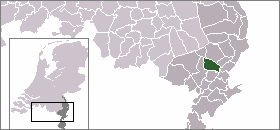Roggel en Neer facts for kids
Roggel en Neer was once a special kind of local government area, called a municipality, in the Netherlands. It was located in the beautiful province of Limburg. Think of a municipality as a town or city, along with the smaller villages and countryside around it, all managed by one local government.
Roggel en Neer included three main villages: Roggel, Neer, and Heibloem. On January 1, 2007, this municipality changed. It became part of a newer, bigger municipality called Leudal.
Contents
What Was Roggel en Neer?
A municipality is like a local government area. It's a way that a country organizes its towns and villages so they can be managed effectively. The people living in a municipality have their own local leaders who make decisions about things like roads, schools, and local services.
Where Was It Located?
Roggel en Neer was found in the southern part of the Netherlands, in the province of Limburg. This area is known for its green landscapes and friendly communities. It's a place with a rich history and a strong connection to Dutch culture.
The Villages It Included
The municipality of Roggel en Neer was made up of three distinct villages, each with its own character:
- Roggel
- Neer
- Heibloem
These villages worked together as part of the same local government until the change in 2007.
A Bit of History
The name Roggel en Neer has its own story. Before 1993, the area was simply known as the municipality of Roggel. The change to "Roggel en Neer" was an important step in its history.
From Roggel to Roggel en Neer
In 1993, the municipality of Roggel officially changed its name to Roggel en Neer. This renaming likely happened to better represent all the main villages that were part of the area, giving Neer equal recognition alongside Roggel. It was a way to show that both communities were important to the municipality's identity.
Joining Leudal
On January 1, 2007, Roggel en Neer stopped being its own separate municipality. It joined forces with several other nearby municipalities to form a new, larger one called Leudal. This kind of change often happens to make local government more efficient and to help communities work together on bigger projects.


